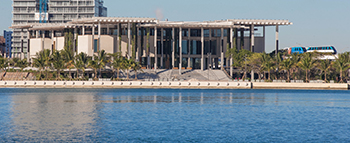Pérez Art Museum Miami Earns LEED Gold
 MIAMI — The Pérez Art Museum Miami (PAMM) announced in March that it has received a LEED Gold rating for its sustainable design, use of local and recycled materials and location with access to public transportation.
MIAMI — The Pérez Art Museum Miami (PAMM) announced in March that it has received a LEED Gold rating for its sustainable design, use of local and recycled materials and location with access to public transportation.
Swiss architecture firm Herzog & de Meuron designed the museum, which opened in downtown Miami’s Museum Park in December 2013.
“Working in harmony with the natural environment to create a world-class model for sustainability was at the heart of the design concept for Pérez Art Museum Miami,” PAMM’s Interim Director Leann Standish said in a statement. “The building was designed to function with as small of a carbon footprint as possible, while ensuring proper temperature and humidity controls needed for conserving, storing and displaying works of art.”
PAMM’s design incorporates sustainable technology from around the world. The museum was the first in the U.S. to use Cobiax voided slab technology, a system that incorporates 100 percent recycled plastic with rebar into concrete slabs, which not only allows for expansive galleries with fewer support columns, but efficiently reduces about 35 percent of the amount of concrete used. The largest single sheets of hurricane resistant glass provide natural light throughout the museum, and the lush vegetation is sustained by rainwater collected in cisterns and a drip-chain system that irrigates greenery from canopy to garage.
South Florida’s tropical climate and severe heat steered designers toward a sustainable temperature control system. PAMM is cooled by a Plenum system that recirculates air through ducts in the building’s floors, rather than ceilings, saving energy and improving efficiency.
The museum is elevated above sea level, which not only puts the waterfront museum at a safe floodplain in the event of a hurricane, but also takes advantage of optimum breeze patterns off the bay, lowering the temperature of the museum’s indoor and outdoor spaces by as much as 10 degrees year-round. A canopy overhead shades the museum from intense sunlight, and PAMM’s hanging gardens create a microclimate throughout the terrace that filters sunlight and cools outdoor display areas.
A solar study was also done to optimize shading and window positioning to take advantage of the climate for maximizing visitor comfort and energy efficiency.
During construction, the architects focused on recycled and local materials, including steel, wood and gypsum extracted from sustainable sites within the state of Florida throughout the museum. Eighty-seven percent of the steel used was recycled, as was a large portion of the non-load-bearing concrete.
Sustainable cork was used for the museum’s seating, and floor coverings are made of Bolon, a recycled flooring alternative. The museum’s curtains are made of recycled fibers and plastics.
Public transportation access, site selection and restoration were also considered in the LEED certification process. PAMM is the former home of an oil refinery, and an extensive remediation process was required to clean the site and turn the land into a valuable resource for the community. The formerly crime-ridden area has now become safe for visitors, allowing for the reopening of public transportation to the park. A Miami-Dade Metromover station is adjacent to the museum, with bus and trolley access, as well as bike racks and a Citi Bike station.
